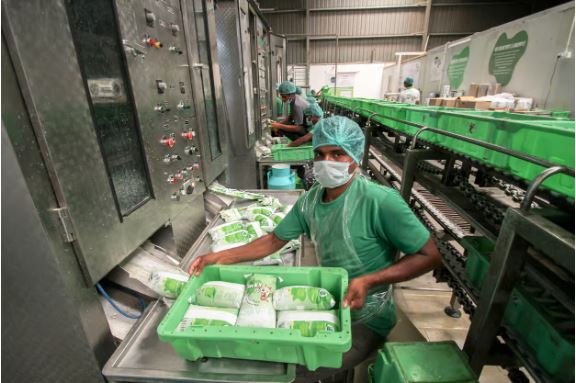
The estimated size of Indian dairy market was about ₹13 lakh crore in 2021 and is expected to reach about ₹31 lakh crore by 2027.
India contributes to more than 25% of global dairy output and has consistently held the top position as the world’s largest milk producer since 1997. In FY23, the country produced around 231 million tonnes of milk, clocking a growth rate of 6% CAGR over the past decade. A report by NITI Aayog predicts that the country’s milk production will reach approximately 300 million tonnes by 2030. On the other hand, Indian households allocate nearly 45% of their food budget to dairy and packaged foods, a trend that has been increasing steadily, says a research report by Investec Research house.
The dairy market in India was estimated to be worth ₹13 lakh
crore in 2021, as per a study by the International Market Analysis Research and Consulting Group (IMARC). Over the past 15 years, the market has shown a steady growth rate of approximately 15% CAGR, and it is anticipated to achieve a market size of about ₹31 lakh crore by 2027 as per IMARC, the leading market research firm.
Thus, India ranks as both the top producer and consumer of dairy products, globally.
The Indian Dairy industry
In India, around 46% of the milk produced is consumed locally or sold to non-producers in rural areas, while the remaining 54% is allocated for sale to organised and unorganised players.
The Indian dairy industry has been largely dominated by the unorganised sector, which has held a 60% share in the liquid milk increasing its share from 32% to 40% over the last three years.
The Department of Animal Husbandry & Dairying (DAHD) predicted that the organised sector’s share will grow to 54% by 2026. Additionally, the influx of capital investments from cooperatives and private players will enable them to establish a strong presence and capture market share from the unorganised sector, the Investec Report adds.
Currently, the liquid milk segment accounts for approximately 61% of the overall Indian dairy market, traditional value-added products contribute 34%, and emerging value-added products comprise the remaining 5%. The liquid milk market is expected to grow at 9% CAGR over the next five years. Traditional value-added products such as paneer, ghee, icecream, khoa, curd, etc. are expected to grow at a 14% CAGR, and emerging value-added products like cheese, flavoured milk, lassi, buttermilk etc. are expected to grow at over 19% per annum.
Growth potential for Dairy in India
Despite being the largest consumer of dairy products, India’s per capita consumption is low as compared to the global standards, indicating an enormous potential for demand growth.
The demand side growth is brought about by growing population, changing lifestyle patterns, increasing disposable incomes, and rising health awareness.
The Supply side is also evolving through technology, changing business models, and product innovation. While the traditional Indian dairy industry is hyperlocal and unorganised, its modern avatar is getting organised, consolidating to garner a wider distribution network, and innovating on value-added products.
As the consumer demand expands beyond traditional liquid milk to value-added dairy products, private players stand to benefit.
Additionally, industry consolidation is expected to further support the growth of private dairy companies, positioning them as viable alternatives to larger cooperatives, points out the Investec Report.
The organised sector is steadily gaining upper hand over the unorganised sector due to urbanisation, more trust on branded goods, and increasing demand for value-added dairy products due to shift in dietary habits and lifestyles. This transformation presents opportunities for private companies offering a diverse range of products and adapting quickly to changing consumer preferences.
The dairy consumers of India, future trends The per capita income in India was $2,600, per annum, in 2023.
The International Monetary Fund (IMF) predicts this number will reach around $4,000 by 2028. This rise in income levels is expected to result in the addition of around 14 crore middle income households and 2.1 crore high-income households in India, by 2030. Furthermore, the share of middle-income households is set to rise from 54% in 2018 to 78% in 2030. It is disposable incomes and drive consumer preference for premium and nutritious food products like milk and milk products, says the Investec Report.
Additionally, the latest National Family Health Survey, 2022, of India highlights that households in the country allocate a significant portion of their budget towards the food segment. The survey also emphasizes a steady rise in discretionary spending within the Food segment over the past two decades, with a consistent growth in dairy products and packaged food products witnessing accelerated growth.
You can now read the most important #news on #eDairyNews #Whatsapp channels!!!
🇮🇳 eDairy News ÍNDIA: https://whatsapp.com/channel/0029VaPidCcGpLHImBQk6x1F

















